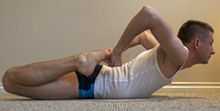Bhekasana
From Wikipedia, the free encyclopedia

Bhekasana (Sanskrit: भेकासन; IAST: Bhekāsana), Mandukasana,[1] or Frog posture[2] is an asana.
Etymology
The name comes from the Sanskrit words Bheka (भेका, bheka) meaning "frog",[1] and asana (आसन) meaning "posture"[3] since the asana resembles a frog.
Benefits and Risks
- Though prolonged practice can cure flat feet.[1][2]
- Relieves pain in the heels due to calcaneal spurs and in knees due to gout[1]
- Stretches ankles, thighs and groins, abdomen and chest, and throat, and deep hip flexors (psoas)[2]
- Strengthens the back muscles[2]
- Improves posture[2]
- Stimulates the organs of the abdomen[2]
- Awakens the kundalini[2]
See also
- Ardha Bhekasana or Half frog pose
- Bhekasana Supta or reclining frog pose
- Kundalini yoga
References
- ↑ 1.0 1.1 1.2 1.3 Iyengar, B.K.S (1979). Light on Yoga. New York: Schocken. pp. 126–8. ISBN 0-8052-1031-8.
- ↑ 2.0 2.1 2.2 2.3 2.4 2.5 2.6 "Yoga Journal – Frog posture". Retrieved 2012-12-07.
- ↑ Sinha, S.C. (1 June 1996). Dictionary of Philosophy. Anmol Publications PVT. LTD. p. 18. ISBN 978-81-7041-293-9. Retrieved 9 April 2011.
Sources
- Iyengar, B. K. S. (1 October 2005). Illustrated Light On Yoga. HarperCollins. ISBN 978-81-7223-606-9.
- Ranjini, V.V.; Paranjape, Kiran; Ramapriyan, H. K.; Gaurav; Las; Glashoff, K.; Mohan, Sam; Gallo, A. (2012). "SpokenSanskrit Dictionary". Retrieved 2012-03-11.
| |||||||||||||||||
This article is issued from Wikipedia. The text is available under the Creative Commons Attribution/Share Alike; additional terms may apply for the media files.